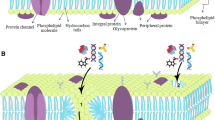Abstract
Recombinant tumstatin was expressed in stably transformed Drosophila melanogaster S2 cells and secreted into the medium with a molecular size of 29 kDa. Recombinant endostatin was also purified to homogeneity using a simple one-step Ni2+ affinity fractionation. Purified recombinant tumstatin inhibited endothelial cell proliferation in a dose-dependent manner. The concentration at half-maximum inhibition for recombinant tumstatin was approx. 0.7 μg ml−1. A maximum production of 4.6 μg recombinant tumstatin (107 cells)−1 was obtained in a T-flask culture of S2 cells, 7 d after induction with 0.5 mM CuSO4.
Similar content being viewed by others
References
Chang KH, Park JH, Lee YH, Kim JH, Chun HO, Kim JH, Chung IS (2002) Dimethylsulfoxide and sodium butyrate enhance the production of recombinant cyclooxygenase 2 in stably transformed Drosophila melanogaster S2 cells. Biotechnol. Lett. 24: 1353–1359.
Finney DJ (1971) Probit Analysis, 3rd edn. Cambridge, UK: Cambridge University Press.
Laemmli UK (1970) Cleavage of structural proteins during the assembly of the head of bacteriophage T4. Nature 227: 680–685.
Maeshima Y, Colorado PC, Torre A, Holthaus KA, Grunkemeyer JA, Ericksen MB, Hopfer H, Xiao Y, Stillman IE, Kalluri R (2000) Distinct antitumor properties of a type IV collagen domain derived from basement membrane. J. Biol. Chem. 275: 21340–21348.
Maeshima Y, Manfredi M, Reimer C, Holthaus KA, Hopfer H, Chandamuri BR, Kharbanda S, Kalluri R (2001) Identification of the anti-angiogenic site within vascular basement membranederived tumstatin. J. Biol. Chem. 276: 15240–15248.
Maeshima Y, Sudhakar A, Lively JC, Ueki K, Kharbanda S, Kahn R, Sonenberg N, Hynes RO, Kalluri R (2002) Tumstatin, an endothelial cell-specific inhibitor of protein synthesis. Science 295: 140–143.
O'Reilly MS, Boehm T, Shing Y, Fukai N, Vasios G, Lane WS, Flynn E, Birkhead JR, Olsen BR, Folkman J (1997) Endostatin: an endogenous inhibitor of angiogenesis and tumor growth. Cell 88: 277–285.
Author information
Authors and Affiliations
Corresponding author
Rights and permissions
About this article
Cite this article
Jeon, H.K., Chang, K.H., Kim, K.I. et al. Functional expression of recombinant tumstatin in stably transformed Drosophila melanogaster S2 cells. Biotechnology Letters 25, 185–189 (2003). https://doi.org/10.1023/A:1022330429508
Issue Date:
DOI: https://doi.org/10.1023/A:1022330429508




